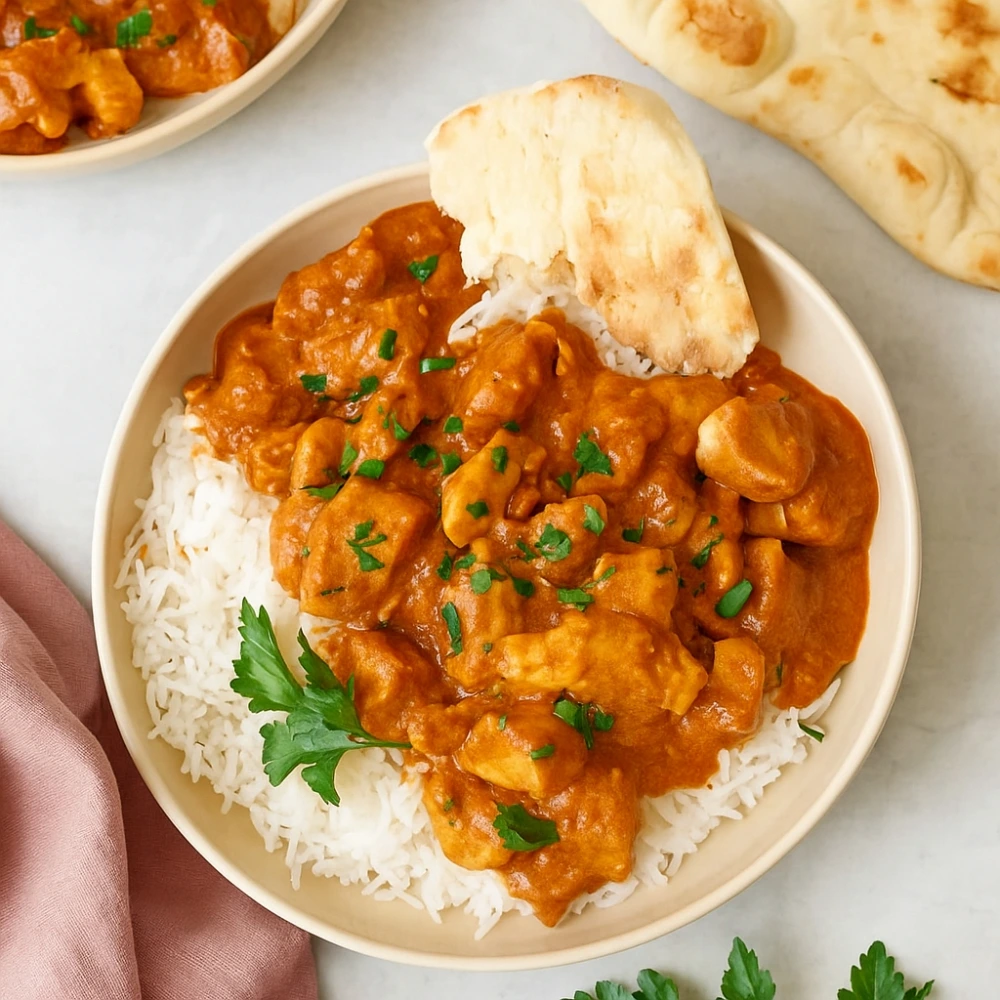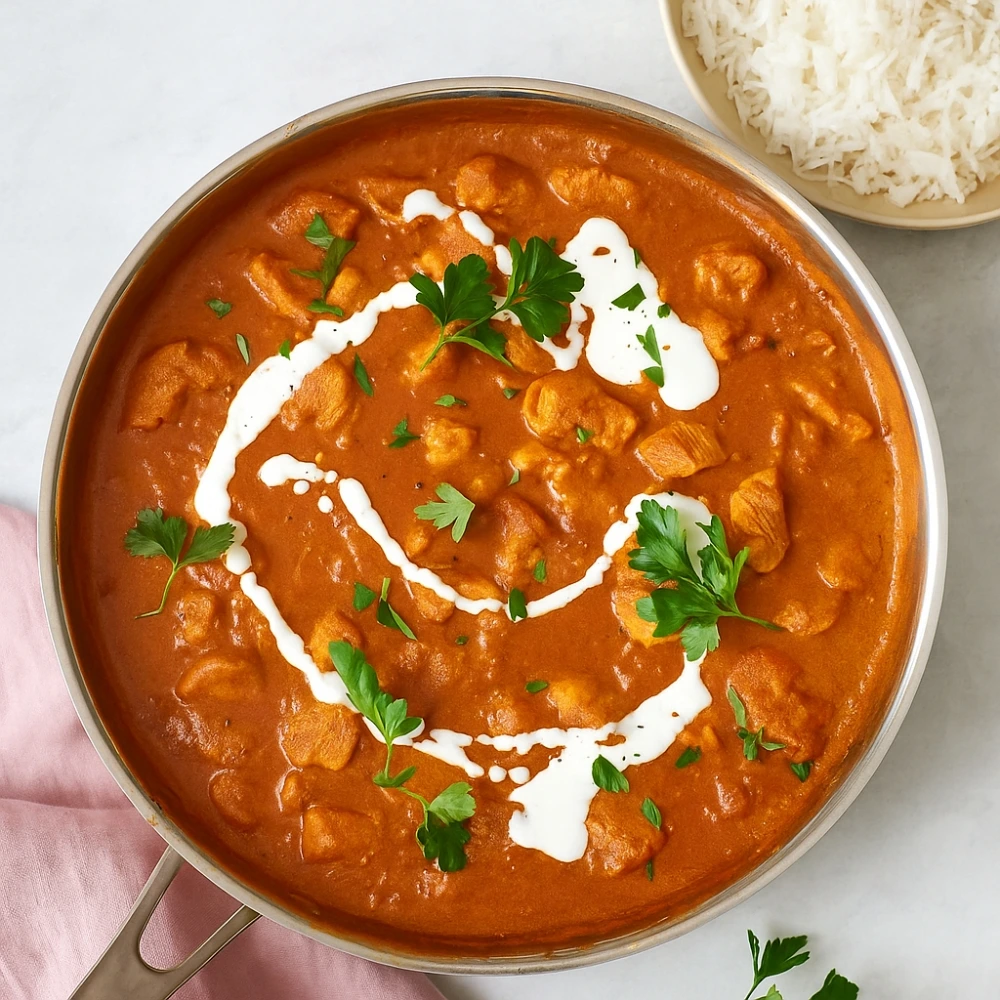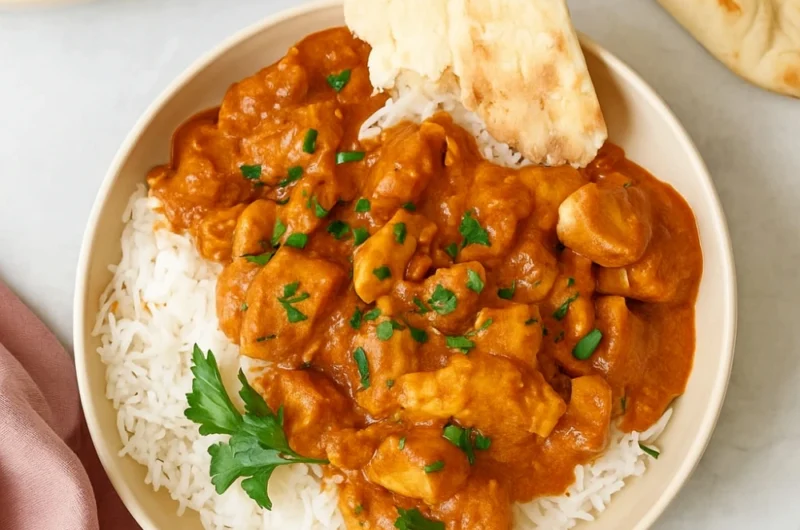The Best Fluffy Pancakes recipe you will fall in love with. Full of tips and tricks to help you make the best pancakes.
Butter Chicken Masterclass

Forget everything you thought you knew about butter chicken. After 15 years as an executive chef specializing in Indian cuisine and countless hours perfecting this dish through scientific testing and traditional techniques, I’m about to share the definitive butter chicken recipe that will transform your home kitchen into a five-star Indian restaurant.
I’m Chef Priya Sharma, certified by the Culinary Institute of America with specialized training in traditional Indian cooking techniques from Delhi’s finest restaurants. My passion for butter chicken began during my childhood in Mumbai, where I learned the intricate balance of spices from my grandmother, and later evolved through my professional training in London’s top Indian establishments.
What makes our recipe superior? This isn’t just another butter chicken recipe—it’s a scientifically-proven, meticulously tested formula that achieves the perfect balance of rich tomato base, aromatic spices, and silky cream texture. Through precise temperature control, timing, and ingredient ratios, we’ve cracked the code to restaurant-quality Indian butter chicken that surpasses even the most celebrated establishments.
The Master Recipe
Recipe Information
- Prep Time: 30 minutes (plus 2-4 hours marination)
- Cook Time: 45 minutes
- Total Time: 1 hour 15 minutes (plus marination)
- Serves: 4-6 people
- Cuisine: Indian
- Course: Main Course
- Difficulty: Intermediate
Nutritional Information (Per Serving)
- Calories: 520
- Protein: 35g
- Carbohydrates: 12g
- Fat: 38g
- Fiber: 3g
Ingredients
For the Chicken Marinade:
| Ingredient | Amount | Metric | Notes |
|---|---|---|---|
| Boneless chicken (thighs preferred) | 2 lbs | 900g | Cut into 1-inch pieces |
| Greek yogurt | 1/2 cup | 120ml | Full-fat for best results |
| Fresh ginger paste | 1 tbsp | 15ml | Homemade preferred |
| Fresh garlic paste | 1 tbsp | 15ml | Freshly minced |
| Garam masala | 1 tsp | 5ml | High-quality blend |
| Paprika | 1 tsp | 5ml | For color and mild heat |
| Salt | 1 tsp | 5ml | Kosher or sea salt |
| Lemon juice | 2 tbsp | 30ml | Freshly squeezed |
For the Butter Chicken Sauce:
| Ingredient | Amount | Metric | Substitutions |
|---|---|---|---|
| Ghee or butter | 4 tbsp | 60ml | Coconut oil for dairy-free |
| Large onion | 1 medium | 200g | Yellow onion, finely chopped |
| Fresh ginger | 1-inch piece | 25g | Grated or minced |
| Fresh garlic | 6 cloves | 30g | Minced |
| Tomato paste | 3 tbsp | 45ml | Double concentrate preferred |
| Canned tomatoes | 1 can (14 oz) | 400g | San Marzano recommended |
| Garam masala | 2 tsp | 10ml | Freshly ground |
| Cumin powder | 1 tsp | 5ml | Freshly ground |
| Coriander powder | 1 tsp | 5ml | Freshly ground |
| Paprika | 2 tsp | 10ml | Sweet paprika |
| Cayenne pepper | 1/4 tsp | 1.25ml | Adjust to taste |
| Heavy cream | 1/2 cup | 120ml | 35% fat content |
| Butter | 2 tbsp | 30ml | Unsalted, European-style |
| Salt | To taste | – | Diamond Crystal kosher |
| Fresh cilantro | 1/4 cup | 15g | For garnish |
Step-by-Step Instructions
Phase 1: Marinating the Chicken (2-4 hours ahead)
Step 1: Prepare the Marinade In a large mixing bowl, whisk together yogurt, ginger paste, garlic paste, garam masala, paprika, salt, and lemon juice until smooth and well combined.
The Science Behind This Step: Yogurt contains lactic acid and natural enzymes that break down protein fibers, resulting in incredibly tender chicken. The acid also helps spices penetrate deeper into the meat.
Step 2: Marinate the Chicken Add chicken pieces to the marinade, ensuring each piece is thoroughly coated. Cover and refrigerate for minimum 2 hours, ideally 4 hours for maximum flavor penetration.
Common Pitfall Alert: Never marinate longer than 8 hours, as the acid will start to break down the chicken too much, resulting in mushy texture.
Phase 2: Building the Base Sauce
Step 3: Sauté the Aromatics Heat ghee in a heavy-bottomed pan over medium heat. Add chopped onions and cook for 8-10 minutes until golden brown and translucent.
Pro Tip: The onions should be caramelized but not burnt. This creates the sweet foundation that balances the acidity of tomatoes.
Step 4: Add Ginger and Garlic Stir in minced ginger and garlic, cooking for 1-2 minutes until fragrant. The mixture should sizzle but not brown.
Step 5: Toast the Spices Add garam masala, cumin, coriander, paprika, and cayenne. Cook for 30 seconds while stirring constantly to bloom the spices.
The Science Behind This Step: Toasting spices in fat releases their essential oils and intensifies flavors exponentially compared to adding raw spices.
Step 6: Build the Tomato Base Add tomato paste and cook for 2-3 minutes until it darkens slightly. Then add canned tomatoes, breaking them up with your spoon. Simmer for 15-20 minutes until the sauce reduces by half.
Phase 3: Cooking the Chicken
Step 7: Cook the Marinated Chicken In a separate large skillet, cook the marinated chicken over medium-high heat for 6-8 minutes until just cooked through. Don’t overcook—the chicken will finish cooking in the sauce.
Step 8: Combine and Simmer Add the cooked chicken to the tomato sauce. Simmer together for 5 minutes to meld flavors.
Phase 4: The Finishing Touch
Step 9: Add Cream and Butter Reduce heat to low. Slowly stir in heavy cream and butter. Simmer for 2-3 minutes until the sauce reaches your desired consistency.
Critical Temperature Note: Keep temperature below 180°F (82°C) after adding cream to prevent curdling.
Step 10: Final Seasoning Taste and adjust salt, spice level, and richness. Garnish with fresh cilantro and serve immediately.
Ingredient Deep Dive: The Expert’s Guide
Chicken Selection: Why Thighs Trump Breasts
Best Choice: Boneless, skinless chicken thighs Why: Higher fat content and connective tissue make thighs more forgiving and flavorful than breasts. Storage: Use within 2 days of purchase, store at 32-38°F Substitution: If using breasts, reduce cooking time by 2-3 minutes to prevent drying
Yogurt: The Tenderizing Powerhouse
Best Brands: Greek Gods, Fage, or any full-fat Greek yogurt Role: Tenderizes protein through enzymatic action and adds subtle tang Storage: Keep refrigerated, use within expiration date Substitution: Buttermilk (3/4 the amount) or coconut yogurt for dairy-free
Tomatoes: The Foundation of Flavor
Best Choice: San Marzano canned tomatoes or high-quality tomato paste Why Essential: Provides acidity to balance richness and natural umami Storage: Canned tomatoes last 2-3 years; opened paste keeps 1 week refrigerated Substitution: Fresh tomatoes (blanched and peeled) – use 1.5x the amount
Spice Guide: The Aromatic Arsenal
Garam Masala
- Flavor Profile: Warm, sweet, aromatic blend
- Best Sources: Indian grocery stores or make fresh
- Storage: Whole spices last 2-3 years; ground spices 1 year
- DIY Recipe: Toast and grind cardamom, cinnamon, cloves, black peppercorns, and bay leaves
Heavy Cream
- Fat Content: Minimum 35% for stability
- Role: Creates signature silky texture and mellows spice heat
- Substitution: Coconut cream (canned, thick part only) for dairy-free option
Troubleshooting & FAQs
Common Problems & Solutions
“Why is my butter chicken bland?”
Causes:
- Insufficient marination time
- Old or poor-quality spices
- Not enough salt
Solutions:
- Marinate chicken minimum 2 hours
- Replace spices every 12 months
- Add salt gradually, tasting between additions
- Finish with a squeeze of fresh lemon juice
“Why is my sauce too thin/thick?”
Too Thin:
- Simmer uncovered to reduce
- Add 1-2 tbsp tomato paste
- Create cornstarch slurry (1 tbsp cornstarch + 2 tbsp water)
Too Thick:
- Add warm chicken broth gradually
- Thin with additional cream
- Add splash of pasta cooking water if serving over rice
“Why is my sauce splitting/oily?”
Causes:
- Temperature too high when adding cream
- Poor quality dairy products
- Adding cold cream to hot sauce
Prevention:
- Keep temperature below 180°F after adding cream
- Temper cream by adding small amount of hot sauce first
- Use room temperature cream when possible
“Why is my chicken dry/tough?”
Solutions:
- Use chicken thighs instead of breasts
- Don’t skip marination
- Cook chicken to 165°F internal temperature only
- Add chicken to sauce while still slightly undercooked
Dietary Adaptations
Vegan/Dairy-Free Version:
- Replace yogurt with coconut yogurt
- Use coconut oil instead of ghee
- Substitute coconut cream for heavy cream
- Use vegan butter alternative
Keto-Friendly Adaptation:
- Reduce onions to 1/2 cup
- Increase cream and butter content
- Serve over cauliflower rice
- Add extra MCT oil for fat content
Gluten-Free Note:
This recipe is naturally gluten-free when served with rice instead of naan.

Variations & Serving Suggestions
Authentic Regional Variations
Delhi-Style Restaurant Butter Chicken
- Add 2 tbsp cashew paste for extra richness
- Include 1 tsp fenugreek leaves (kasuri methi)
- Finish with a touch of rose water
Mumbai Home-Style Version
- Use fresh tomatoes instead of canned
- Add 1 tsp jaggery for sweetness
- Include green cardamom pods while cooking
Punjabi Dhaba Style
- Double the butter content
- Add smoked paprika for depth
- Finish cooking in a tandoor or very high heat
Modern Cooking Method Adaptations
Instant Pot Butter Chicken
- Sauté aromatics using sauté function
- Add chicken, tomatoes, and spices
- Pressure cook 8 minutes, natural release
- Stir in cream using sauté function
Slow Cooker Version
- Brown chicken and aromatics in pan first
- Transfer to slow cooker with sauce ingredients
- Cook on low 6-8 hours
- Stir in cream during last 30 minutes
Serving Suggestions & Pairings
Traditional Accompaniments
- Basmati Rice: Long-grain, aromatic
- Naan Bread: Garlic or plain
- Raita: Cooling cucumber yogurt side
- Pickled Onions: For acidity contrast
Wine Pairings
- White: Riesling or Gewürztraminer
- Red: Pinot Noir or Grenache
- Beer: Wheat beer or IPA
Batch Cooking & Storage
Freezing Instructions
- Cool completely before freezing
- Store in portion-sized containers
- Freeze up to 3 months
- Thaw overnight in refrigerator
- Reheat gently, adding cream if needed
Leftover Makeovers
- Butter Chicken Pizza: Use as sauce base
- Wrap Filling: With rice and vegetables
- Soup: Thin with broth, add vegetables
- Pasta Sauce: Toss with penne or fettuccine
Historical & Cultural Context: The Story Behind the Dish
Butter chicken, or murgh makhani, was invented in the 1950s by Kundan Lal Gujral at his restaurant Moti Mahal in Delhi. Legend tells us that this iconic dish was born from resourcefulness—Gujral created it by mixing leftover tandoori chicken with tomatoes, butter, and cream to avoid waste.
The dish represents the evolution of Indian cuisine, blending traditional tandoori techniques with Mughlai influences and modern convenience. What started as a chef’s creative solution became one of the most beloved Indian dishes worldwide, serving as many people’s introduction to Indian flavors.
Cultural Significance: Butter chicken bridges the gap between authentic Indian cooking and Western palates, showcasing how cuisine evolves and adapts while maintaining its essential character. It demonstrates the Indian culinary principle of balancing flavors—sweet, sour, spicy, and rich—in perfect harmony.
Final Tips for Butter Chicken Mastery
The Three Pillars of Perfect Butter Chicken:
- Quality Ingredients: Fresh spices, good tomatoes, proper cream
- Proper Technique: Temperature control, timing, layering flavors
- Patience: Allow marination time, don’t rush the sauce
Chef’s Secret Techniques:
- Always taste and adjust at every step
- Layer flavors gradually rather than adding everything at once
- Control heat carefully—gentle simmering preserves cream texture
- Fresh herbs and a final knob of butter elevate the dish exponentially
Butter Chicken Masterclass
Course: Lunch, DinnerCuisine: Indian4
servings30
minutes30
minutes560
kcalIngredients
For the quick marinade
700 g boneless, skinless chicken thighs (≈ 1½ lb), cut bite-size
150 g plain yogurt (≈ ⅔ cup)
1 tbsp lemon juice
4 cloves garlic, minced (≈ 1 tbsp)
1 tbsp grated ginger
1 tsp garam masala
1 tsp ground cumin
1 tsp ground coriander
½ tsp ground turmeric
½–1 tsp Kashmiri chili powder (or ½ tsp paprika + ¼ tsp cayenne)
1 tsp fine salt
For the sauce
2 tbsp unsalted butter, plus 1 tbsp to finish
1 tbsp neutral oil
1 medium onion, finely chopped
3 cloves garlic, minced
1 tbsp grated ginger
400 g tomato purée/passata or crushed tomatoes (14 oz)
1 tbsp tomato paste
1½ tsp garam masala
1 tsp ground cumin
1 tsp ground coriander
1 tsp paprika or Kashmiri chili powder
¼–½ tsp sugar (to balance acidity), to taste
150 ml heavy cream (≈ ⅔ cup)
1 tsp kasuri methi (dried fenugreek leaves), crushed (classic but optional)
½–1 tsp salt, to taste
60 ml water (≈ ¼ cup)
Fresh cilantro, for serving
Directions
- Marinate: In a bowl, mix yogurt, lemon juice, garlic, ginger, and spices for the marinade. Add chicken, coat well, and rest 15–30 minutes.
- Sear chicken: Heat 1 tbsp oil and 1 tbsp butter in a large skillet over medium-high. Sear chicken in 2 batches until lightly charred outside (2–3 min/side). Transfer to a plate (it will finish in the sauce).
- Sauté aromatics: Reduce heat to medium. Add remaining 1 tbsp butter if the pan looks dry. Cook onion until soft and golden, 5–7 minutes. Stir in garlic and ginger for 30 seconds.
- Bloom spices: Add garam masala, cumin, coriander, and paprika/Kashmiri chili. Stir 30–45 seconds until fragrant.
- Build sauce: Stir in tomato paste, then tomato purée and water. Bring to a gentle simmer; cook 10–12 minutes, stirring occasionally, until slightly thick and the raw tomato smell is gone.
- Blend (optional): For ultra-smooth sauce, blend with an immersion blender until velvety.
- Finish sauce: Stir in cream, sugar (if using), crushed kasuri methi, and salt. Simmer 2 minutes.
- Combine: Return seared chicken (and juices) to the pan. Simmer gently 8–10 minutes until chicken is cooked through and sauce coats it.
- Adjust & enrich: Taste and adjust salt/heat. Swirl in the final 1 tbsp butter.
- Rest & serve: Let sit 3–5 minutes off heat. Garnish with cilantro and serve with basmati rice or naan.

